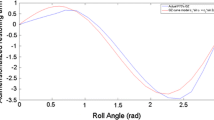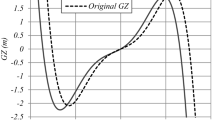Abstract
This paper aims to describe a probabilistic assessment technique for ship roll behavior in beam sea conditions. Here, following the work of Kimura and its previous application by the author, probability density function (pdf) of roll response is calculated by combining the moment method with equivalent linearization technique. Results produced using this method are shown to be in good agreement with Monte Carlo simulation results. Moreover, this procedure is extended to the estimation of the capsizing probability. The final results concerning capsizing probability for the linear damping coefficient case are well correlated to the Monte Carlo simulation results. The advantage of this method is that it does not require a significant amount of computation and it enables the direct assessment of capsizing probability for ships with strongly nonlinear restoring terms.













Similar content being viewed by others
References
Belenky VL (1993) A capsizing probability comparison method. J Ship Res 37:200–207
Belenky VL (1994) Piecewise linear method for the probabilistic stability assessment for ship in a seaway, 5th International Conference on Stability of Ship and Ocean Vehicle, Melbourne, vol 5, No. 2, pp 1–18
Umeda N, Yamakoshi Y (1991) Assessment for probability of ship capsizing due to pure loss of stability in quartering seas (in Japanese). J Soc Naval Archit Jpn 169:15–25
Paroka D, Ohkura Y, Umeda N (2006) Analytical prediction of capsizing probability of a ship in beam wind and waves. J Ship Res 50(2):187–195
Maeda E, Kubo T, Umeda N (2012) Theoretical methodology for quantifying probability of capsizing for a ship in beam wind and waves and its numerical validation. J Jpn Soc Naval Archit Ocean Eng 15:227–235
Themelis N, Spyrou KJ (2007) Probabilistic assessment of ship stability. Trans SNAME 115:181–206
Kougioumtzoglou LI, Spanos PD (2014) Stochastic response analysis of the softening Duffing oscillator and ship capsizing probability determination via a numerical path integral approach. Probab Eng Mech 35:67–74
Chai W, Naess A (2015) Stochastic dynamic analysis and reliability of a vessel rolling in random beam seas. J Ship Res 59(2):113–131
Haddara MR (1974) A Modified Approach for the Application of Fokker-Plank Equation to the Nonlinear Ship Motion in Random Waves. Int Shipbuild Prog 21:283–288
Roberts JB (1982) A stochastic theory for nonlinear ship rolling in irregular seas. J Ship Res 26(4):229–245
Francescutto A, Naito S (2004) Large Amplitude Rolling in a Realistic Sea. Int Shipbuilding Prog 51(2, 3):221–235
Kimura K (1995) Non-Gaussian equivalent linearization for estimation of stochastic response distribution of nonlinear systems (in Japanese). Trans Jpn Soc Mech Eng C 61 583:831–835
Maki A (2013) Roll motion of the ships have non-linear restoring characteristic in random Beam Seas (in Japanese). In: Proceedings of the Japan Society of Naval Architects and Ocean Engineers vol 16, pp 347–349
Maki A (2013) Stochastic research on roll motion of surface combatants in irregular Beam Seas (in Japanese). Technical Report of Technical Research and Development Institute, Ministry of Defense, No. 7127
Sakata K, Kimura K (1979) The use of moment equations for calculating the mean square response of a linear system to non-stationary random excitation. J Sound Vibration 67(3):383–393
Sakata K, Kimura K (1980) Calculation of the non-stationary mean square response of a non-linear system subjected to non-white excitation. J Sound Vibration 73(3):333–343
Kimura K, Morimoto T (1998) Estimation of non-Gaussian response distribution of a nonlinear system subjected to random excitation: application to nonwhite excitation with nonrational spectrum (in Japanese). J Jpn Soc Mech Eng 64(617):1–6
Kimura K, Sakata M (1980) Non-stationary responses of a non-symmetric non-linear system subjected to a wide class of random excitation. J Sound Vibration 76(2):261–272
Caughey TK (1963) Derivation and application of the Fokker–Planck equation to discrete nonlinear dynamic systems subjected to white noise random excitation. J Acoust Soc Am 35(2):1683–1692
Belenky VL, Weems KM (2012) Dependence of roll and roll rate in nonlinear ship motions in following and stern Quartering Seas. 11th International Conference on Stability of Ship and Ocean Vehicle, Melbourne, pp 57–66
Belenky VL, Sevastianov NB (2007) Stability and safety of ships: risk of capsizing (2nd edition). SNAME
Belenky VL, Weems KM, Lin W (2008) Numerical procedure for evaluation of capsizing probability with split time method. In: Proceedings of the 27th Symposium on Naval Hydrodynamics, Seoul, CD
Scott DW (1979) On optimal and data-based histograms. Biometrika 66(3):605–610
Acknowledgements
The author is grateful to Dr. Vadim Belenky in NSWCCD (Naval Ship Warfare Center Carderock Division) for his technical advice and discussion. Further, the author is grateful to Mr. Parker Field in NSWCCD (Naval Ship Warfare Center Carderock Division) for his comprehensive review of this paper.
Author information
Authors and Affiliations
Corresponding author
Appendices
Appendix 1
Here, the derivation of Eq. 14 is briefly explained. Consider the following linear differential equation with the excitation term.
The solution of the above linear differential equation is described using the impulse response function \( H_{12} \) and \( H_{22} \) as follows [16]:
Here, putting \( \omega_{\text{h}} = \sqrt {\omega_{0}^{2} - \alpha_{\text{e}}^{2} /4} \), the impulse response function and the other terms are described as follows:
In Eq. 32, integral terms represent the homogeneous solution, whereas the later part represents the particular solution. Now, the stationary solution is necessary for analysis, and in this case, the homogeneous solution does not contribute. Then, the following relation can be obtained:
Here, \( R\left( {t - v} \right) = E\left[ {f\left( v \right)\,f\left( t \right)} \right] \) is the autocorrelation function of external wave moment. Putting \( k \equiv t - v \), then it becomes as follows:
Appendix 2
Here, the analytical expressions of \( E\left[ {f\left( t \right)\,\phi \left( t \right)} \right] \) and \( E\left[ {f\left( t \right)\,\dot {\phi } \left( t \right)} \right] \) in Eq. 14 are shown. The functions in integrals are oscillating ones having the following form:
The accuracy of the value obtained from this equation strongly influences the final results; so, it should be analytically calculated. The results of the integral with respect to time t becomes as follows:
About this article
Cite this article
Maki, A. Estimation method of the capsizing probability in irregular beam seas using non-Gaussian probability density function. J Mar Sci Technol 22, 351–360 (2017). https://doi.org/10.1007/s00773-016-0415-9
Received:
Accepted:
Published:
Issue Date:
DOI: https://doi.org/10.1007/s00773-016-0415-9




